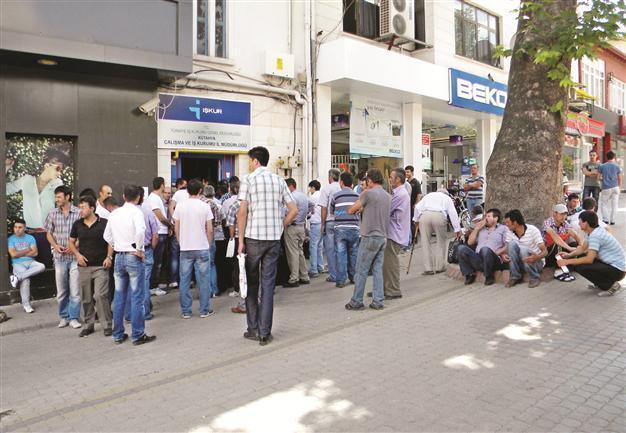Male, youngsters dominate unemployment applications
ANKARA - Anatolia News Agency

A group of people are seen waiting in front of a Labor Institution office in the Aegean province of Kütahya in this photo taken earlier this month. Some 37 percent of the job applicants to the state body are between the ages of 15 and 24, data show. AA photo
Some 63 percent of people applying to the Turkish Labor Institution (İŞKUR) are male, a recent study shows. Some of the applicants are between the ages of 15 and 24.“An average of 520,000 people applied to İşkur every year between 2001 and 2007. The figure surpassed 1 million as of 2008. Unemployment schemes and a substantial increase in [financial] resources allocated to programs for the active labor force contributed to the increase in applications. There was a record number of applications to İşkur in 2009 with more than 1.4 million. The figure hit nearly 1.4 million in 2011. Some 856,661 people have registered at İşkur in the first seven months of this year,” said İşkur General Manager Nusret Yazıcı.
İşkur’s influence in the labor market has strengthened in recent years, as the staff of the body has been increased, according to Yazıcı.
Female applicants on rise
The number of women who applied to İşkur has significantly increased in recent years, he said. The ratio of women applying to İşkur climbed to 38.5 percent in 2011 from 24.7 percent in 2004. Some 37.6 percent of the applications between January and July this year were lodged by women, he added.
“Most of the applications to İşkur come from people aged between 15 and 24. Some 37.3 percent of the total applicants are from that age group as of the end of July. This goes for both men and women. The second most applicants are between the ages of 25 and 34. The proportion of applications decreases in older age groups. Only 4.7 percent of the applicants are age 50 and older,” he said.
The highest numbers of applicants are, in decreasing order, manual laborers, office clerks, caretakers, accountants, salespeople, waiters and computer operators, he said, noting that nearly half of the applicants have occupations that do not require qualifications.
“The rate of people who were put to work in the private sector was 44 percent in 2004. The figure hit 83.6 percent in 2011,” he said. The rate of women put to work was 28.7 percent last year, up from 16 percent in 2004.
















